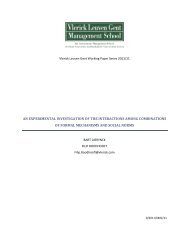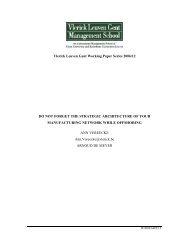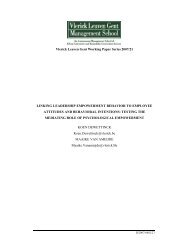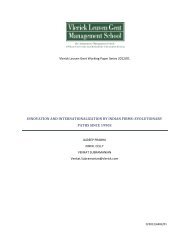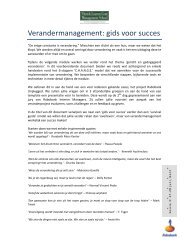Vlerick Leuven Gent Working Paper Series 2007/03 ... - Vlerick Public
Vlerick Leuven Gent Working Paper Series 2007/03 ... - Vlerick Public
Vlerick Leuven Gent Working Paper Series 2007/03 ... - Vlerick Public
You also want an ePaper? Increase the reach of your titles
YUMPU automatically turns print PDFs into web optimized ePapers that Google loves.
Explaining the inconclusive findings in board research<br />
Many explanations can be given for the lack of consistent findings in empirical<br />
research on the direct relationship between the board of directors and corporate performance.<br />
In essence, they all boil down to two issues. These are (i) a lack of clear construct definition,<br />
and (ii) the reliance on incomplete research models.<br />
First, the diverging findings have been attributed to the varying definitions and<br />
operationalizations of the constructs used in empirical research. Daily et.al. (1999), for<br />
example, identified over twenty separate ways of defining board composition. The earliest<br />
studies distinguished inside from outside directors and board composition was measured using<br />
three different approaches: (absolute) number of outsiders, industry inside-outside norm and<br />
outsider/insider proportion or dominance 2 (Zahra and Pearce, 1989). Later on, researchers<br />
increasingly wanted to capture the independence of the outside directors and have been<br />
separating independent directors from interdependent or affiliated directors, who are<br />
considered to be characterized by a lack of independence. In such an approach, board<br />
composition has been operationalized by the independent/interdependent distinction or by the<br />
proportion of affiliated directors (Dalton et.al., 1998). In addition to the complexity of<br />
uniformly defining board composition, the measurement of performance is also subject to<br />
considerable discussions (Venkatraman and Ramanujam, 1986; Hawawini et.al., 20<strong>03</strong>).<br />
Although some scholars rely on market-based measures, research on boards of directors has<br />
been dominated by accounting measures (Dalton et.al., 1998; Coles et.al., 2001).<br />
Performance measures rooted in financial accounting are being criticized because they (i) are<br />
subject to managerial manipulation, (ii) undervalue assets, (iii) are influenced by accounting<br />
standards such as depreciation policies, inventory valuation and treatment of certain revenue<br />
and expenditure items and (iv) are affected by differences in methods for consolidation of<br />
accounts (Chakravarthy, 1986). Furthermore, a review by Johnson et al. (1996) has revealed a<br />
list of distinct financial performance measures on which empirical research has relied,<br />
emphasizing the fact that certain measures have additionally been adjusted to account for<br />
industry effects or risk in a different manner. Consequently, the variety in definitions and<br />
measures applied in empirical research makes comparison of studies difficult and may cause<br />
the inconsistent findings.<br />
2 Proportion was calculated by dividing the number of outside or inside directors to board size. In contrast, “dominance”<br />
denoted the existence of a large majority of outside or inside directors on the boards, and was treated as a dichotomous<br />
variable (outsider versus insider-controlled)<br />
6



